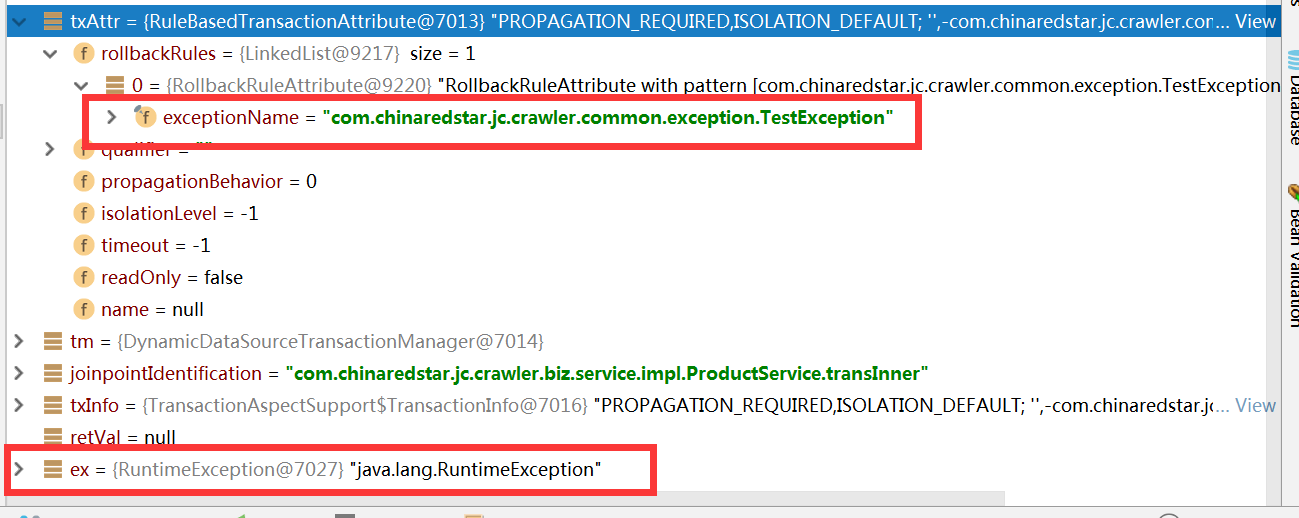一次Spring Transactional嵌套事务使用不同的rollbackFor的分析
起因:
项目期间由于一次异常回滚问题,发现自己在事务知识方面知识的遗漏,趁着这次机会,做了几次rollbackFor的测试。
测试:
现在有两个事务,事务oute包含事务Inner。事务A回滚规则是当事务抛出TestException,其中TestException继承RunTimeException。事务B的回滚规则是事务抛RuntimeException。事务的传播方式都是使用的默认,即 Propagation.REQUIRED。如以下代码:
@Override
@Transactional(rollbackFor = TestException.class)
public void transOuter() {
productMapper.updateOrderQuantityPessimistic(product_code1);
((ProductService) AopContext.currentProxy()).transInner();
} @Transactional(rollbackFor = Exception.class)
public void transInner() {
productMapper.updateOrderQuantityPessimistic(product_code);
if (true) {
throw new RuntimeException();
}
}
以下为TestException的代码。
public class TestException extends RuntimeException {
public TestException(String message) {
super(message);
}
}
一开始按照自己对事务的理解, 默认的传播属性之下。事务B启动的时候,会默认使用事务A的rollbackFor来进行回滚,所以该代码运行时候。程序不会回滚。
然而测试,测试完之后发现事务A、B都进行了回滚。
看着测试结果产生了疑问。难道是以innner的rollBack为准?接着进行测试。
@Override
@Transactional(rollbackFor = Exception.class)
public void transOuter() {
productMapper.updateOrderQuantityPessimistic(product_code1);
((ProductService) AopContext.currentProxy()).transInner();
} @Transactional(rollbackFor = TestException.class)
public void transInner() {
productMapper.updateOrderQuantityPessimistic(product_code);
if (true) {
throw new RuntimeException();
}
}
再次测试,测试完之后发现事务A、B依然进行了回滚。
感觉自己对事务的理解还是太浅薄了,是时候debug一波源码。
分析源码:
查看 org.springframework.transaction.interceptor.TransactionAspectSupport 类的 invokeWithinTransaction方法。该方法是事务执行的主要方法,这里我们主要看第20行的事务捕捉那一块。completeTransactionAfterThrowing的方法。
protected Object invokeWithinTransaction(Method method, Class<?> targetClass, final InvocationCallback invocation)
throws Throwable { // If the transaction attribute is null, the method is non-transactional.
final TransactionAttribute txAttr = getTransactionAttributeSource().getTransactionAttribute(method, targetClass);
final PlatformTransactionManager tm = determineTransactionManager(txAttr);
final String joinpointIdentification = methodIdentification(method, targetClass); if (txAttr == null || !(tm instanceof CallbackPreferringPlatformTransactionManager)) {
// Standard transaction demarcation with getTransaction and commit/rollback calls.
TransactionInfo txInfo = createTransactionIfNecessary(tm, txAttr, joinpointIdentification);
Object retVal = null;
try {
// This is an around advice: Invoke the next interceptor in the chain.
// This will normally result in a target object being invoked.
retVal = invocation.proceedWithInvocation();
}
catch (Throwable ex) {
// 事务异常捕捉主要在这边获取
completeTransactionAfterThrowing(txInfo, ex);
throw ex;
}
finally {
cleanupTransactionInfo(txInfo);
}
commitTransactionAfterReturning(txInfo);
return retVal;
} else {
// It's a CallbackPreferringPlatformTransactionManager: pass a TransactionCallback in.
try {
Object result = ((CallbackPreferringPlatformTransactionManager) tm).execute(txAttr,
new TransactionCallback<Object>() {
@Override
public Object doInTransaction(TransactionStatus status) {
TransactionInfo txInfo = prepareTransactionInfo(tm, txAttr, joinpointIdentification, status);
try {
return invocation.proceedWithInvocation();
}
catch (Throwable ex) {
if (txAttr.rollbackOn(ex)) {
// A RuntimeException: will lead to a rollback.
if (ex instanceof RuntimeException) {
throw (RuntimeException) ex;
}
else {
throw new ThrowableHolderException(ex);
}
}
else {
// A normal return value: will lead to a commit.
return new ThrowableHolder(ex);
}
}
finally {
cleanupTransactionInfo(txInfo);
}
}
}); // Check result: It might indicate a Throwable to rethrow.
if (result instanceof ThrowableHolder) {
throw ((ThrowableHolder) result).getThrowable();
}
else {
return result;
}
}
catch (ThrowableHolderException ex) {
throw ex.getCause();
}
}
}

这边显示当事务的rollbackFor为TestException,而抛出的异常为RunTimeException时候。跟我们的transInner一致。接着往下看 completeTransactionAfterThrowing 方法。主要看第8行,第8行对事务进行判断,是否对该抛出的异常进行回滚。
protected void completeTransactionAfterThrowing(TransactionAspectSupport.TransactionInfo txInfo, Throwable ex) {
if (txInfo != null && txInfo.hasTransaction()) {
if (logger.isTraceEnabled()) {
logger.trace("Completing transaction for [" + txInfo.getJoinpointIdentification() +
"] after exception: " + ex);
}
//这里主要判断事务捕获了异常以后,是否进行回滚
if (txInfo.transactionAttribute.rollbackOn(ex)) {
try {
txInfo.getTransactionManager().rollback(txInfo.getTransactionStatus());
}
catch (TransactionSystemException ex2) {
logger.error("Application exception overridden by rollback exception", ex);
ex2.initApplicationException(ex);
throw ex2;
}
catch (RuntimeException ex2) {
logger.error("Application exception overridden by rollback exception", ex);
throw ex2;
}
catch (Error err) {
logger.error("Application exception overridden by rollback error", ex);
throw err;
}
}
else {
// We don't roll back on this exception.
// Will still roll back if TransactionStatus.isRollbackOnly() is true.
try {
txInfo.getTransactionManager().commit(txInfo.getTransactionStatus());
}
catch (TransactionSystemException ex2) {
logger.error("Application exception overridden by commit exception", ex);
ex2.initApplicationException(ex);
throw ex2;
}
catch (RuntimeException ex2) {
logger.error("Application exception overridden by commit exception", ex);
throw ex2;
}
catch (Error err) {
logger.error("Application exception overridden by commit error", ex);
throw err;
}
}
}
}
再深入点进去看,看到第11行,这边获取该异常的深度。跳转到片段二进行代码查看。
public boolean rollbackOn(Throwable ex) {
if (logger.isTraceEnabled()) {
logger.trace("Applying rules to determine whether transaction should rollback on " + ex);
}
RollbackRuleAttribute winner = null;
int deepest = Integer.MAX_VALUE;
if (this.rollbackRules != null) {
for (RollbackRuleAttribute rule : this.rollbackRules) {
//获取异常的深度?
int depth = rule.getDepth(ex);
if (depth >= 0 && depth < deepest) {
deepest = depth;
winner = rule;
}
}
}
if (logger.isTraceEnabled()) {
logger.trace("Winning rollback rule is: " + winner);
}
// User superclass behavior (rollback on unchecked) if no rule matches.
if (winner == null) {
logger.trace("No relevant rollback rule found: applying default rules");
//如果depth为-1之后,父类的回滚方式
return super.rollbackOn(ex);
}
return !(winner instanceof NoRollbackRuleAttribute);
}
根据深度代码查看,rollbackFor和抛出异常ex不一致,返回-1。再回去看上面的代码片段,当返回-1之后,代码走到第28行。进行父类的回滚方法。
private int getDepth(Class<?> exceptionClass, int depth) {
if (exceptionClass.getName().contains(this.exceptionName)) {
// Found it!
return depth;
}
// If we've gone as far as we can go and haven't found it...
//此处RuntimeException 跟TestException不一致,返回-1
if (exceptionClass == Throwable.class) {
return -1;
}
return getDepth(exceptionClass.getSuperclass(), depth + 1);
}
以下是父类的代码是否回滚判断方法,有没有很眼熟,只要抛出的异常的是RunTimeExcpetion或者Error则进行回滚。
public boolean rollbackOn(Throwable ex) {
return (ex instanceof RuntimeException || ex instanceof Error);
}
总结
根据上面的代码,我们可以推断出以下几个结论:
1、当我们抛出的异常为RunTime及其子类或者Error和其子类的时候。不论rollbackFor的异常是啥,都会进行事务的回滚。
2、当我们抛出的异常不是RunTime及其子类或者Error和其子类的时候,必须根据rollbackfor进行回滚。比如rollbackfor=RuntimeException,而抛出IOException时候,事务是不进行回滚的。
3、当我们抛出的异常不是RunTime及其子类或者Error和其子类的时候,如果嵌套事务中,只要有一个rollbackfor允许回滚,则整个事务回滚。
经过测试,上述的结论也没发现什么问题。
最新文章
- python的class的__str__()和__repr__()函数
- php性能分析工具 - xhprof的安装使用
- ExtJs创建环境搭建
- 存储过程Oracle学习(一)
- js button onclick动作赋值操作
- POJ 1144 Network(Tarjan)
- Codevs 1009 产生数
- Silverlight的Socket通信
- hadoop得知;datajoin;chain署名;combine()
- LDA 线性判别分析
- 提纲挈领webrtc之vad检测
- iOS学习——UI相关小结
- Android开发学习之路--Activity之四种启动模式
- JAVA第一周学习
- Robot Framework 自动化测试 Selenium2Library 库 用法
- html转markdown网站
- Docker 小记 — Docker Engine
- Springboot杂七杂八
- Google 日历短信通知没有了
- .NET WinForm下StatusStrip控件如何设置分隔线及部分子控件右对齐